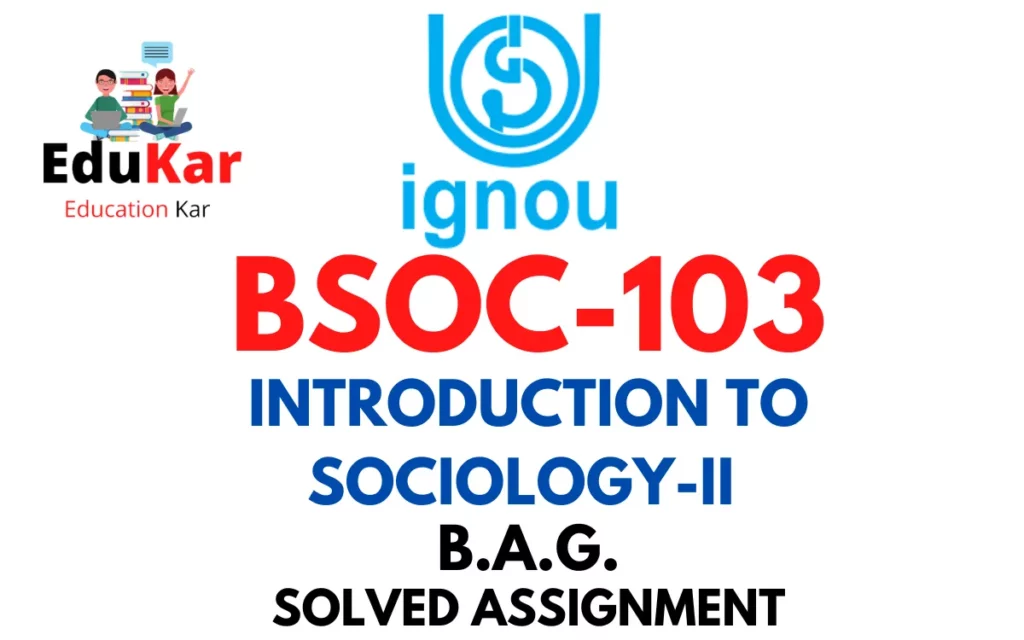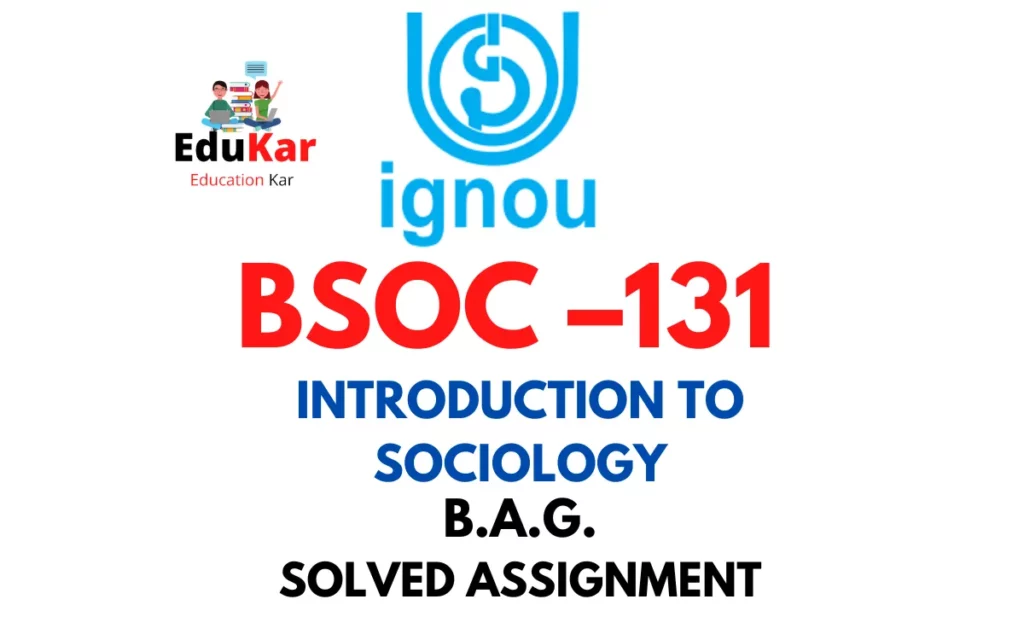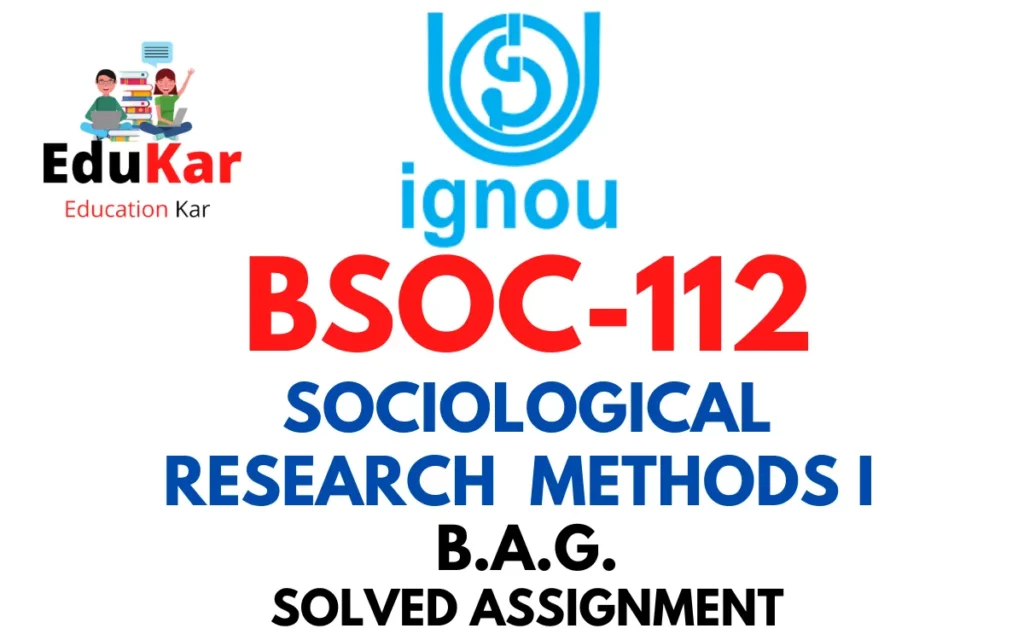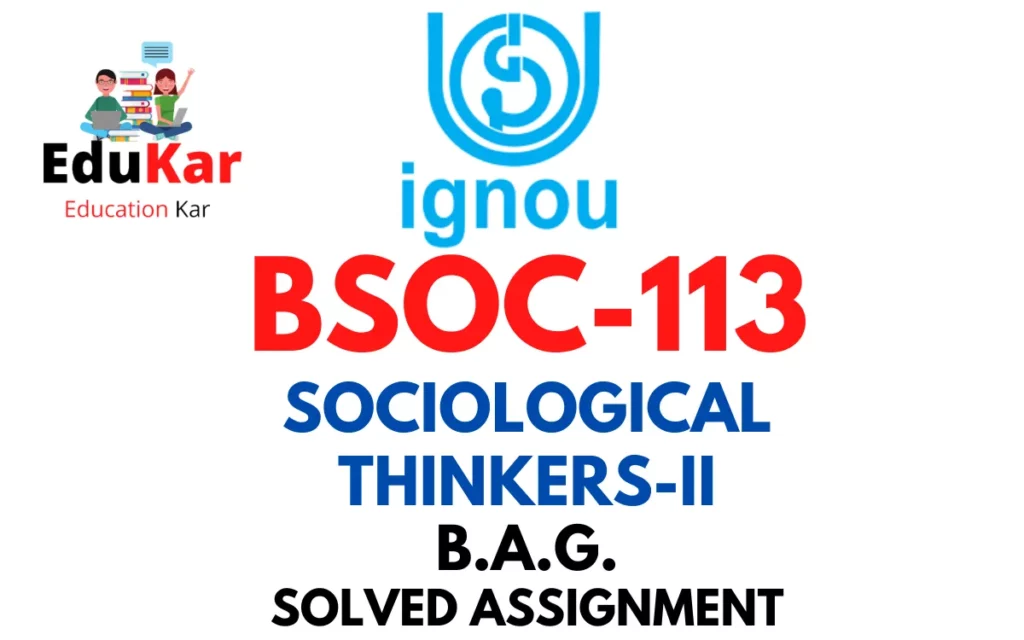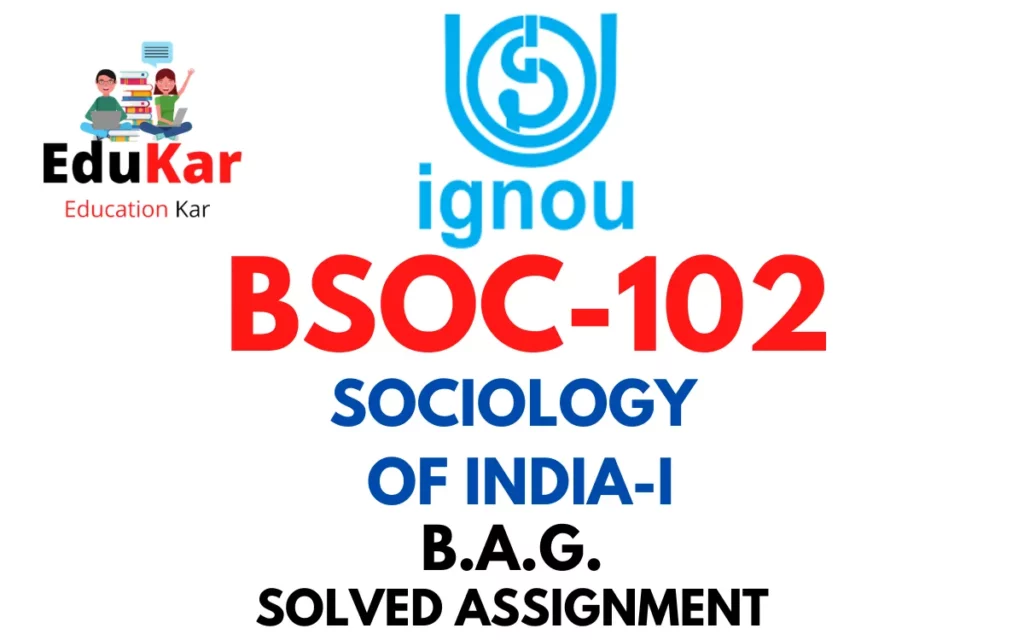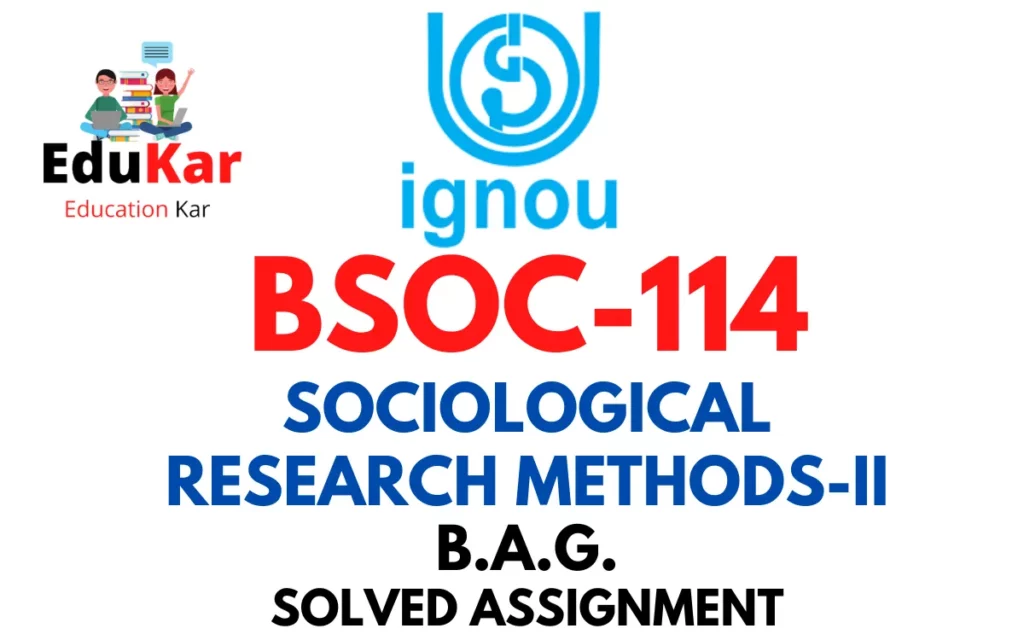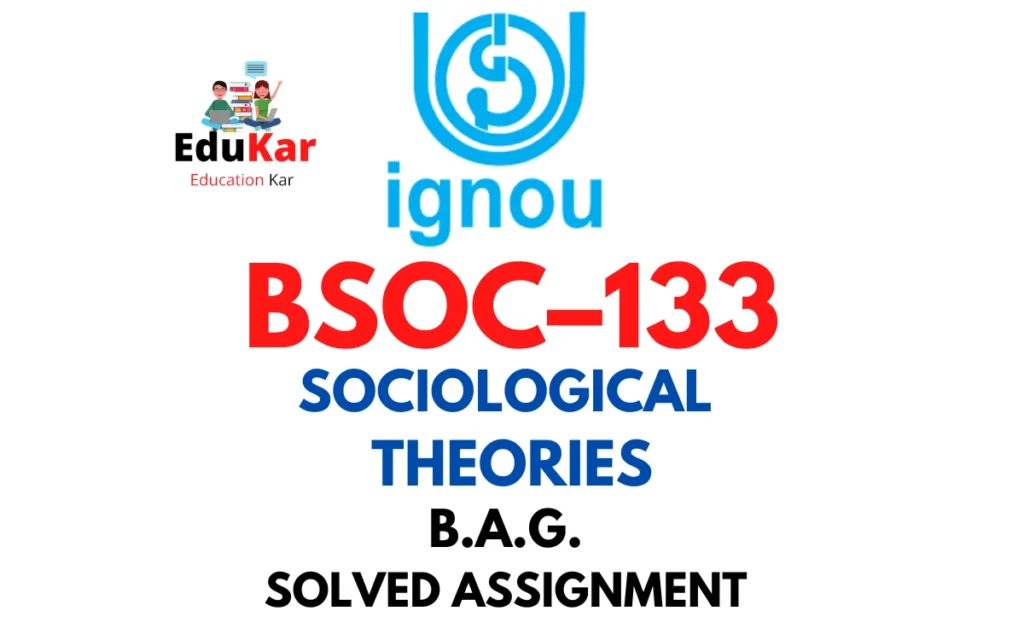Contents
- 1 Assignment – I
- 2 Answer the following in about 500 words each.
- 3 1. Explain the phenomenology perspectives in Sociology.
- 4 2. What are the basic elements of theory?
- 5 Assignment – II
- 6 Answer the following in about 250 words each.
- 7 3. Explain the significance of ideal type.
- 8 4. What is the evolutionist method? Name some thinkers who have used this method.
- 9 5. Elaborate the comparative methods used by Durkheim and Redcliffe-Brown.
- 10 Assignment – III
- 11 Write a note on the following in about 100 words each.
- 12 6. Discuss Feminist empiricism.
- 13 7. Elaborate the various stages of quantitative research.
- 14 8. Discuss ICT impacts in social sciences research.
- 15 9. What is survey?
- 16 10. Discuss various sources of history.
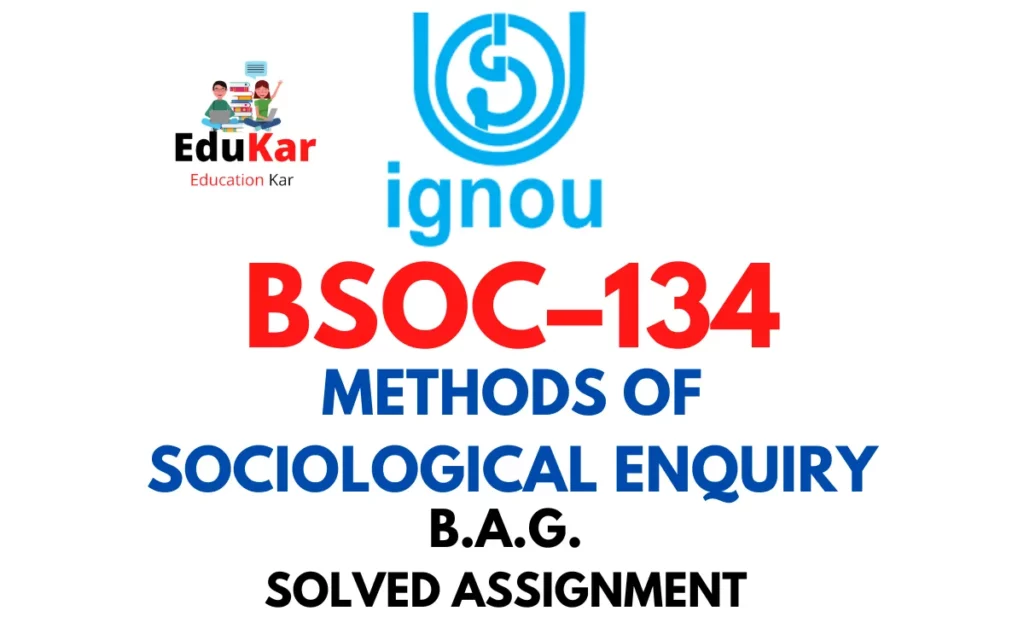
| Title | BSOC-134: IGNOU BAG Solved Assignment 2022-2023 |
| University | IGNOU |
| Degree | Bachelor Degree Programme |
| Course Code | BSOC–134 |
| Course Name | METHODS OF SOCIOLOGICAL ENQUIRY |
| Programme Name | Bachelor of Arts (General) |
| Programme Code | BAG |
| Total Marks | 100 |
| Year | 2022-2023 |
| Language | English |
| Assignment Code | Asst /TMA /2022-23 |
| Last Date for Submission of Assignment: | For June Examination: 31st April For December Examination: 30th September |
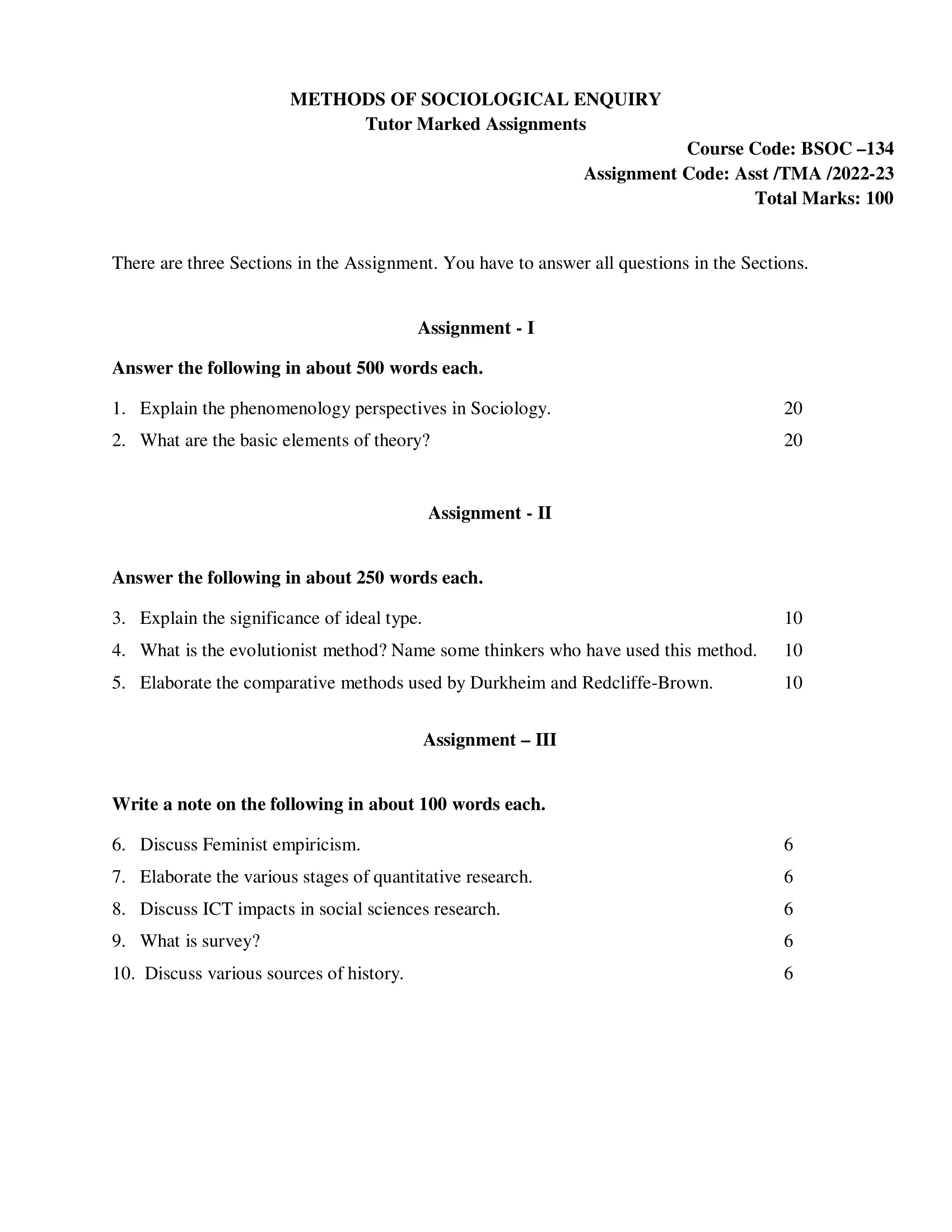
Assignment – I
Answer the following in about 500 words each.
1. Explain the phenomenology perspectives in Sociology.
Ans: Phenomenology is a philosophical and sociological perspective that emphasizes the subjective experiences and interpretations of individuals as the basis for understanding social phenomena. In sociology, phenomenology has been used as a framework for analyzing social interactions, relationships, and institutions. This perspective holds that individuals actively create and interpret their social worlds, and that their interpretations are influenced by their personal experiences and cultural backgrounds.
One key concept in phenomenology is the “lifeworld,” which refers to the individual’s subjective and lived experience of the world. This includes their thoughts, emotions, perceptions, and bodily sensations, as well as their relationships with others and their environment. Phenomenological sociology seeks to understand how individuals make sense of their lifeworld, and how their subjective experiences shape their social interactions.
Another important concept in phenomenology is “intersubjectivity,” which refers to the shared understanding and communication between individuals. Phenomenological sociology recognizes that social interactions are not simply a matter of individual actions, but are instead influenced by the shared meanings and interpretations that individuals bring to the interaction. For example, a conversation between two people is not simply a matter of two individuals exchanging words, but is instead shaped by their shared cultural background, personal experiences, and social context.
Phenomenological sociology has been used to analyze a wide range of social phenomena, including the experience of illness and disability, the meaning of work, the nature of power and domination, and the construction of gender and identity. This perspective has also been used to critique traditional sociological theories that emphasize objective structures and processes, arguing that these theories overlook the subjective experiences and interpretations of individuals.
Overall, phenomenological sociology provides a rich and nuanced perspective on social interactions and institutions, emphasizing the importance of subjective experiences and interpretations. This approach recognizes that social phenomena are not simply a matter of objective facts or structures, but are instead shaped by the active and creative interpretations of individuals.
2. What are the basic elements of theory?
Ans: A theory is a set of ideas or principles that explain a particular phenomenon or set of phenomena. The development of a theory involves the identification of the basic elements or components that are necessary to explain the phenomenon under study. These elements are typically grounded in empirical evidence, and the theory must be capable of explaining and predicting future observations. The basic elements of theory can be grouped into several categories, including:
- Concepts: Concepts are the building blocks of theory, and refer to the abstract ideas or constructs that represent the key elements of the phenomenon being studied. For example, in a theory of human motivation, concepts might include needs, desires, and goals.
- Variables: Variables are the operationalized forms of concepts, and refer to the specific measures or indicators used to assess the presence or absence of the concept. For example, in a theory of human motivation, a variable might be the number of times an individual engages in a particular behavior.
- Propositions: Propositions are the relationships between concepts and variables, and describe the ways in which they are thought to interact. For example, in a theory of human motivation, a proposition might be that individuals who have a higher need for achievement are more likely to engage in goal-oriented behaviors.
- Assumptions: Assumptions are the underlying beliefs or values that guide the development of the theory, and provide the context for the other elements of the theory. For example, in a theory of human motivation, an assumption might be that individuals are driven by internal factors such as personal goals and desires.
- Hypotheses: Hypotheses are specific predictions or statements that can be tested through empirical research. They are derived from the other elements of the theory, and are used to assess the validity and applicability of the theory. For example, in a theory of human motivation, a hypothesis might be that individuals with high achievement needs will be more likely to engage in goal-oriented behaviors than individuals with low achievement needs.
Assignment – II
Answer the following in about 250 words each.
3. Explain the significance of ideal type.
Ans: Ideal type is a concept in sociology that was introduced by the German sociologist Max Weber. It refers to an abstract concept or model that is used by sociologists to understand social phenomena. An ideal type is a tool that is used to simplify and clarify complex social realities. It is not an accurate representation of any particular social phenomenon but a conceptualization of a particular aspect of it.
The significance of ideal type is that it helps sociologists to analyze social phenomena and understand the underlying patterns that are not immediately visible. By creating an ideal type, sociologists can identify the key characteristics that define a particular phenomenon and differentiate it from other phenomena. This, in turn, allows sociologists to make generalizations about social phenomena and develop theories that can explain their behavior.
Ideal types are particularly useful in comparative analysis. By creating an ideal type for each social phenomenon under consideration, sociologists can compare the characteristics of each ideal type and identify similarities and differences. This can help them to understand the causes of these similarities and differences and develop more comprehensive theories about social phenomena.
4. What is the evolutionist method? Name some thinkers who have used this method.
Ans: The term “evolutionist method” can refer to different methods or approaches depending on the context, but in general, it is used to describe a scientific approach that emphasizes the study of change over time and the historical development of organisms, societies, and other phenomena.
In biology, the evolutionist method refers to the scientific method used to study the processes of biological evolution. This includes the formulation of testable hypotheses, the collection of empirical evidence, the use of statistical and computational methods to analyze data, and the development of theoretical models to explain the observed patterns and processes.
Some of the key thinkers who have contributed to the development of the evolutionist method in biology include Charles Darwin, Alfred Russel Wallace, Thomas Huxley, Ernst Mayr, Theodosius Dobzhansky, and Richard Dawkins.
In the social sciences, the evolutionist method refers to various approaches that emphasize the study of historical development and change over time, including cultural evolution, social evolution, and historical materialism. Some of the key thinkers who have used or contributed to the development of the evolutionist method in the social sciences include Herbert Spencer, Lewis Henry Morgan, Karl Marx, Friedrich Engels, and Émile Durkheim.
5. Elaborate the comparative methods used by Durkheim and Redcliffe-Brown.
Ans: Émile Durkheim and A.R. Radcliffe-Brown were both prominent anthropologists who made significant contributions to the development of comparative methods in anthropology. While they shared some similarities in their approach, they also had some notable differences in their methodological and theoretical perspectives.
Durkheim’s comparative method focused on identifying and analyzing the social structures and institutions of different societies in order to uncover universal patterns and underlying principles of social organization. He believed that by comparing different societies, researchers could identify the fundamental social facts that govern human behavior and that underlie all social systems.
Durkheim used a variety of comparative methods, including statistical analysis, historical comparison, and ethnographic comparison. He also emphasized the importance of studying social facts as they existed in their natural context, rather than simply imposing theoretical categories onto them. Durkheim’s work focused on understanding the relationship between social structure and individual behavior, and he argued that social facts were objective and could be studied scientifically.
In contrast, Radcliffe-Brown’s comparative method was more focused on the functional analysis of social systems, and he was particularly interested in identifying the underlying mechanisms that maintained social order and stability. He believed that by comparing different societies and their institutions, researchers could uncover the common functions that these institutions served and the ways in which they contributed to the maintenance of social order.
Radcliffe-Brown used a variety of comparative methods, including the cross-cultural comparison of institutions, the analysis of structural similarities and differences, and the identification of functional equivalents in different societies. He also emphasized the importance of studying social structures and institutions as integrated parts of a larger social system, rather than as isolated entities.
Assignment – III
Write a note on the following in about 100 words each.
6. Discuss Feminist empiricism.
Ans: Feminist empiricism is an approach to social research that combines feminist theory with empirical methods. The goal of feminist empiricism is to create knowledge that is not only accurate and reliable but also takes into account the experiences and perspectives of women and other marginalized groups. This approach seeks to challenge the dominant paradigms of scientific inquiry that have historically ignored the experiences of women and other oppressed groups. Feminist empiricists believe that scientific inquiry should be guided by principles of social justice and that research methods should be designed to address the unique needs and experiences of different populations. This approach has contributed to the development of feminist theories that challenge the gendered assumptions and biases that are present in many traditional theories and research methods.
7. Elaborate the various stages of quantitative research.
Ans: Quantitative research is a research method that involves collecting and analyzing numerical data to test hypotheses, identify patterns, and establish relationships between variables. The following are the various stages of quantitative research:
- Research Design: The first stage of quantitative research is to identify the research question or problem and select an appropriate research design. This involves specifying the research objectives, identifying the population to be studied, and selecting the appropriate sampling method.
- Data Collection: The next stage of quantitative research is to collect data. This can be done using a variety of methods, including surveys, questionnaires, and experiments. Data can also be collected using existing databases or archival data.
- Data Processing: Once data has been collected, it needs to be processed. This includes coding and entering data into a statistical software program. The data is checked for errors and cleaned to ensure that it is accurate and reliable.
- Data Analysis: The next stage of quantitative research is to analyze the data. This involves using statistical methods to test hypotheses, identify patterns, and establish relationships between variables. The data can be analyzed using descriptive statistics or inferential statistics.
- Interpretation: The final stage of quantitative research is to interpret the results. This involves analyzing the findings and drawing conclusions about the research question or problem. The findings are compared to existing literature and theoretical frameworks to assess their relevance and significance.
Ans: Information and communication technologies (ICT) have had a profound impact on social sciences research, providing researchers with new tools and methods for collecting and analyzing data, collaborating with colleagues and stakeholders, and disseminating their findings to a wider audience. Some of the key impacts of ICT on social sciences research include:
- Data Collection: ICT has made it easier and more efficient to collect and analyze large amounts of data from a variety of sources. Researchers can now use online surveys, social media monitoring, and other digital tools to gather data from participants all over the world. ICT has also enabled the development of new methods for data analysis, such as machine learning and data mining.
- Collaboration: ICT has made it easier for researchers to collaborate with colleagues and stakeholders, regardless of their geographic location. Tools such as video conferencing, online collaboration platforms, and cloud-based storage have made it easier to share data and work together on research projects in real-time.
- Dissemination: ICT has revolutionized the way in which social sciences research is disseminated and shared with the wider public. Researchers can now use online platforms to publish their findings, share their data, and engage with a wider audience. Social media has also made it easier to communicate research findings and engage with stakeholders and the wider public.
- Ethics: The use of ICT in social sciences research has raised new ethical concerns, such as privacy, informed consent, and the use of sensitive data. Researchers must be aware of these issues and take appropriate steps to ensure that their research is conducted ethically and in compliance with relevant regulations.
9. What is survey?
Ans: A survey is a research method that involves gathering information from a sample of individuals or groups using standardized questionnaires or interviews. Surveys can be used to collect data on a wide range of topics, including attitudes, opinions, beliefs, behaviors, and demographics. The data gathered from surveys can be used to identify patterns, trends, and relationships between different variables, providing valuable insights into the attitudes and behaviors of the population being studied. Surveys can be conducted using a variety of methods, including online surveys, telephone interviews, mail surveys, and in-person interviews. Surveys can be a cost-effective and efficient way of collecting data, but they must be carefully designed and executed to ensure that the data collected is accurate and reliable.
10. Discuss various sources of history.
Ans: History is a broad field that encompasses a wide range of sources, including written records, archaeological artifacts, oral traditions, and material culture. Some of the key sources of history include:
- Written records: Written records are perhaps the most common and well-known sources of history. These include official documents, such as government records, court documents, and financial records, as well as personal documents such as diaries, letters, and memoirs. Written records can provide valuable insights into the attitudes, beliefs, and practices of people in the past, as well as important historical events and social movements.
- Archaeological artifacts: Archaeological artifacts, such as pottery, tools, and weapons, provide physical evidence of past cultures and societies. These artifacts can be used to reconstruct the daily life of people in the past, as well as the economic, political, and social structures of ancient societies.
- Oral traditions: Oral traditions are another important source of history, particularly for cultures and societies that did not have a tradition of written records. These include myths, legends, and folk tales, as well as oral histories and personal narratives. Oral traditions can provide valuable insights into the beliefs, customs, and practices of people in the past, as well as the historical events that shaped their lives.
- Material culture: Material culture refers to the objects and artifacts created by people in the past, including art, architecture, and clothing. These objects can provide valuable insights into the beliefs, values, and practices of people in the past, as well as the cultural and historical context in which they lived.
- Secondary sources: Secondary sources are works that analyze and interpret primary sources, such as historical documents and archaeological artifacts. These can include books, academic articles, and other scholarly works that provide critical analysis of historical events, movements, and social structures.
How to Download BSOC–134 Solved Assignment?
You can download it from the www.edukar.in, they have a big database for all the IGNOU solved assignments.
Is the BSOC–134 Solved Assignment Free?
Yes this is absolutely free to download the solved assignment from www.edukar.in
What is the last submission date for BSOC–134 Solved Assignment?
For June Examination: 31st April, For December Examination: 30th October

